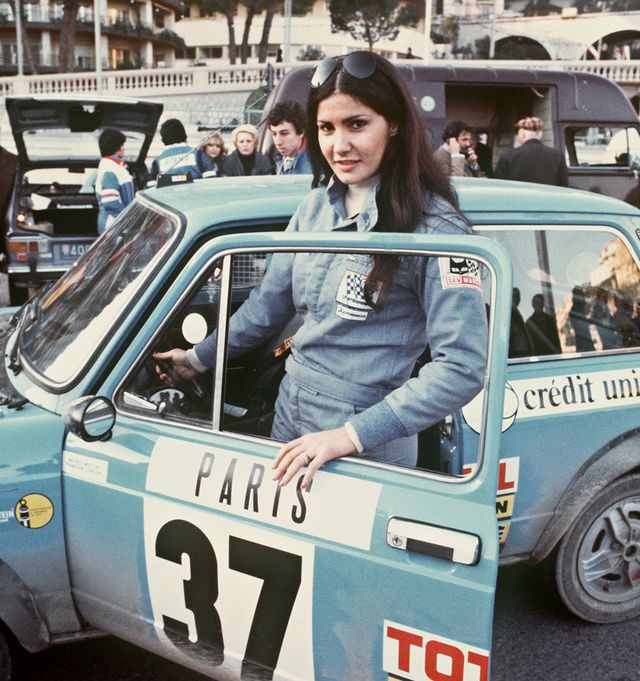From the June 2023 issue of Car and Driver.
I first learned about Michèle Mouton when I was in my early 20s, just about the same age she was when she first got in a race car in 1973, the inaugural year of the World Rally Championship. The race was the famously difficult Monte Carlo Rally, and Mouton was navigating for a friend. She said she had no idea what she was getting into: “When he first asked me if I wanted to co-drive for a rally, I said, ‘What’s rally?'”
I was working at a motorcycle shop and had also never heard of rally racing. One of the mechanics told me I looked like “that French lady driver.” I didn’t, but I did wear my dark hair in long braids and had a habit of glaring at people—so, close enough. I looked her up. A few vintage rallying films later, I was smitten, with both Mouton and the insanity of rally events in the 1980s. The races were lawless, the cars experimental. It was an era of racing so dangerous that there’s a documentary about it called Rallying: The Killer Years. Mouton was a killer too, ferocious behind the wheel of a Group B Audi Quattro. Nicknamed the Black Volcano and la femme qui dérange, she won races with her co-driver Fabrizia Pons at a time and in a discipline that didn’t have any women at the top level (and hasn’t since).
Mouton would be annoyed by my saying she was the only woman. In fact, she corrected me during a panel discussion at DirtFish Rally School. “I was not the first woman to race rally,” she said. “Back then, it was the opposite of now: many women in rally, not so many in road racing.”
“But you were the first to win,” another journalist said, and I pointed out that Mouton has also done road racing, winning her class at the 1975 24 Hours of Le Mans. Mouton shrugged and gave a half smile. She’s very modest. If I were Mouton, I’d tell everyone “I almost won the Group B championship!”
She should have. She went into the penultimate race of 1982 trailing Walter Röhrl by only seven points. The morning of the first stage, she learned her father had died. Her mother told her to race anyway, and she did, building a lead of more than an hour over Röhrl. If not for a muffed gearbox change, Mouton would have gone into the last race of the season with the championship in hand. She would win again, but never would she and Pons be in the championship hunt, as 1983 was her last full season in WRC. She never complains, but I will. It’s impossible to win the championship when you aren’t sent to the races.
Even so, she continued to upset the regulars everywhere she did race. In 1984, she ran Pikes Peak, and in 1985, she won it, despite a hostile reception from the other drivers and numerous fines and penalties from the officials.
To Mouton, the stories are relics, as cobwebby as the trophies she keeps in a cardboard box in her backyard shed. She’s proud of having been the first woman to win a WRC rally, but she thinks it’s a shame that she’s still the only woman to have won a WRC rally. She’d rather talk about her years as president of the FIA Women in Motorsport Commission, where she worked on ways to get more women in racing, an effort she’s still devoted to.
Despite her reluctance to look back, Mouton did grace us with a few stories of the good ol’ days, recounting how she and Pons would cook foil-wrapped sausages on the Audi turbo during recce. “Two or three runs, and they’d start to smell good.” She also told us her first factory ride—the Fiat 131 Abarth—was so hard to drive that her hands would blister and bleed, and co-driver Françoise Conconi would have to reach over to pull on the wheel to help make the turns. “Everyone asks how I could drive the Group B Audi, such a difficult car,” she said, laughing. “It’s easy compared to the Fiat. It has power steering.”

Senior Editor, Features
Like a sleeper agent activated late in the game, Elana Scherr didn’t know her calling at a young age. Like many girls, she planned to be a vet-astronaut-artist, and came closest to that last one by attending UCLA art school. She painted images of cars, but did not own one. Elana reluctantly got a driver’s license at age 21 and discovered that she not only loved cars and wanted to drive them, but that other people loved cars and wanted to read about them, which meant somebody had to write about them. Since receiving activation codes, Elana has written for numerous car magazines and websites, covering classics, car culture, technology, motorsports, and new-car reviews.

